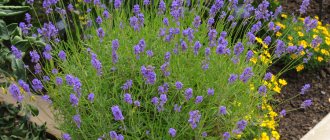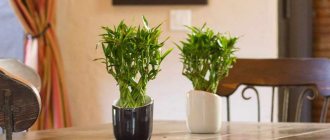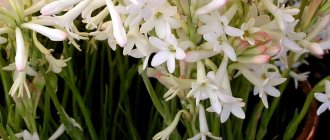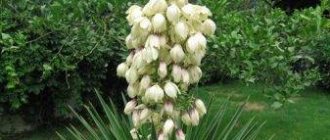These colorful plants belong to the Lamiaceae family - they are relatives of sage and mint. Previously, the genus Coleus consisted of about 150 species, but in the modern classification only two remain: Coleus decurrens and Coleus forskohlii. And all the rest, including Coleus Bloome (this is what is grown at home) were classified as another genus - the spur flower. And our homemade coleus is now officially called Plectranthus scutellarioides. But what’s most interesting is that Carl Linnaeus originally named this Coleus basilica (Ocimum scutellarioides). This is the plant’s confusing history. But we, paying tribute to tradition, will call it coleus.
Our homemade coleus comes from the tropical regions of Asia and Africa. In warm regions it is grown in open ground, but in the harsh realities of Russia it has taken root as a houseplant. By the way, coleus began to be grown as an ornamental plant not so long ago: the first mention of it in this status was found only in 1918 - it was included in the list of plants of the Antilles (1). A variety of shapes and colors appeared in 1918 in Bermuda.
Coleus is a herbaceous plant, but in the lower part its shoots become woody. In nature, it can reach a height of 1.5 m. It blooms with inconspicuous panicles of different shades of blue.
Coleus varieties
There are a great many varieties of coleus. They differ in height, shape and color of leaves:
- Freckles - orange leaves with large yellow spots, height 25 - 35 cm;
- Wizard Velvet Red - deep burgundy leaves with a light green border along the edges, height 30 - 35 cm;
- Wizard Pastel - leaves with patterns of cream, pink and green shades, height 30 - 35 cm;
- Dragon Black - fringed leaves of dark red color with a wide purple border, height 30 - 35 cm;
- Collins Gold - with corrugated yellow leaves with a wide green stripe in the center and rare burgundy spots, height 25 - 35 cm;
Wizard Pastel. Photo: pixabay.com
Wizard Velvet Ed. Photo: pixabay.com
Saturn. Photo: pixabay.com
Weasley Tapestry. Photo: pixabay.com
- Saturn - leaves of red-chestnut color with a wide green spot in the middle and a thin green edging along the edge, height 30 - 40 cm;
- Twist and Twirl - variegated leaves, with a succession of yellow, green, red and brown shades, height 30 - 40 cm;
- Wisley Tapestry - ampelous variety, red leaves, with a wide yellow-green border, height 30 - 35 cm;
- Hedwig - yellow-green leaves with a large burgundy spot at the base and numerous specks and strokes of the same shade, height 30 - 35 cm.
Coleus care at home
Coleus is an unpretentious plant, but there are several nuances that must be taken into account when growing.
Priming
The ideal soil mixture for coleus is a mixture of leaf soil, turf soil, peat and sand in a ratio of 1:1:1:1 (2). But you don’t have to worry about it; in general, coleus plants are undemanding when it comes to soil; you can grow them in purchased universal soil or special soil for decorative foliage plants.
Temperature
During the period of active growth (from March to October), coleus requires a temperature within 25 ° C. And in winter it needs cooler content - 16 - 20 ° C. At higher temperatures, the plants stretch out, however, this is not a problem - they can be pruned in the spring.
Lighting
These plants are very photophilous and can grow even in direct sunlight. In the shade they become very elongated, their color noticeably fades. The ideal place for coleus is east or south windows.
Humidity
Coleus loves abundant watering - if the soil dries out, it instantly withers. He also likes high air humidity, so it is useful to spray the plants from time to time, especially on hot days in summer.
Fertilizers
When planting in a pot, you do not need to add any fertilizers - for the first time, the soil for coleus contains all the necessary nutrients.
Feeding
The first feeding of coleus can be given 2 weeks after planting. In the future, feeding should be as follows:
- from the end of March to the end of February, feed once a week;
- from November to March – once every 2 weeks.
It is best to use liquid complex fertilizers - any will do.
Trimming
Coleus tend to stretch out, exposing the lower parts of the shoots, so from time to time you need to pinch the tops of the coleus - this way it will bush better.
If the coleus has become very elongated in winter, in March it can be cut into a stump, leaving 5 - 8 buds.
Advantages of whitewashing trees with lime and copper sulfate
Often, inexperienced gardeners have the misconception that whitewashing trees is done for aesthetic purposes. Indeed, neatly planted trees with white trunks look much more beautiful, but lime and copper sulfate for whitewashing trees protect the bark from at least three unfavorable factors:
- Burns. In winter, the sun's rays are reflected in snowdrifts, which is why tree bark runs the risk of getting burned.
- Temperature changes. In the off-season, the air temperature at night and during the day is very different, which is why cracks may appear on the bark.
- Pests. Insects and their larvae are easily found in the bark after winter, and their penetration is prevented by applying a chemical composition.
Propagation of coleus at home
To propagate coleus, 2 methods are used.
Cuttings
This is the simplest option; the cuttings of these plants quickly and easily produce roots - in an ordinary glass of water they appear within 8 - 12 days (2). Rooted cuttings can be immediately planted in pots.
Seeds
Coleus seeds are sown in plastic containers from February to March. They are evenly distributed over the surface of the moist soil and lightly sprinkled with sand. At a temperature of 20 °C, seedlings appear after 2 weeks. During growth, they need to be picked three times (2):
- in the cotyledon stage;
- when the second pair of true leaves appears;
- a month after germination - at this time they can be planted in permanent pots.
Features of flowering
The flowering of coleus cannot be called a decorative process, so at this time many gardeners do not pay much attention to the subshrub. In this phase, the nettle produces blue-violet flowers that gather in complex inflorescences. At this time, the flower spends a large amount of vitality, so the best option after the formation of the inflorescence is to remove it. In some varieties, the flowers exude a pleasant aroma, but the subshrubs look inconspicuous at this time.
Coleus diseases
Coleus practically does not get sick, but it may have problems associated with improper care.
Coleus is withering. There are 3 reasons for this phenomenon:
- insufficient watering - coleus plants are sensitive to drought;
- drafts - these plants cannot tolerate sudden changes in temperature and may even die;
- cold window sill - if the soil is cold, the roots are not able to extract water from it and even with watering the plants wither.
Leaves are falling. The reason is lack or excess of watering.
The leaves are turning pale. This happens if the plant does not have enough light.
Useful properties of the plant
The plant is completely harmless and safe, ideal for growing indoors.
It has no effect on children or pets; on the contrary, some cats may eat the leaves as they contain medicinal properties. In many homes, the flower is used not at all as a home decoration, but as part of a first aid kit with “Grandmother’s Herbs”. It has long been known that, like most herbs, Coleus plants have a good effect on metabolism. The main component of the flower is the presence of forskolin. Forskolin has a beneficial effect on the absorption of vitamins and nutrients by the body. Therefore, Coleus is not only a beautiful, but also a useful crop in every home.
There are many superstitions about the plant among the people. There is an opinion that it has enormous potential, with the help of which stagnant, low frequencies are replaced with higher, healthier ones.
There are also many signs and superstitions about the flower, for example several of them:
- Coleus on the desktop brings good luck in business;
- If a flower withers in the house, wait for the illness of a loved one;
- If flowering occurs in winter, then this portends poverty;
- If Coleus is in the house, then there will be no place for moths in it.
Popular questions and answers
We talked about coleus with agronomist-breeder Svetlana Mikhailova - we asked her the most popular questions from amateur gardeners.
How to choose coleus?
When buying coleus, pay attention to its appearance: the leaves should be bright and elastic. If possible, remove the plant from the pot with a lump of earth and inspect the roots. Ideally, they are well entwined and have no signs of rotting.
What should be the pot for coleus?
Pots with a diameter of 9 cm are suitable for young plants and rooted cuttings. For adults - about 20 cm. Coleus look good in clay slides, but in this case they will have to be watered much more often.
Is it possible to grow coleus outdoors?
Can. And even necessary - in the open air they grow much better and look brighter. It is generally recommended to take them out onto the balcony in the summer. But you can also plant it in the garden - at the end of May, when the threat of spring frosts has passed. And in the fall, the plants can be dug up and planted again in the hills. Or cut and root the cuttings and leave the old coleus in the garden.
Can I keep it at home?
In the photo: Coleus / Coleus Henna
Before giving advice on caring for coleus at home, we decided to write about whether it is possible to keep this flower at home.
According to Feng Shui
Ancient Chinese teachings advise placing coleus in a corner where negative energy usually circulates. Its leaves will take it upon themselves.
In the northeastern part of an apartment or house, according to Feng Shui, the energy of wisdom and knowledge accumulates. This is where it is recommended to place a pot with a house plant.
Opinion of esotericists
It is believed that growing coleus at home gives only positive results. But it's best to put it:
- in the kitchen, where he will clean the energy;
- in the bedroom so that your sleep becomes good and your dreams become good;
- in the hallway to recognize envious and evil people (after visiting them, the leaves of the nettle begin to fade).
Esotericists claim that if a plant’s leaves suddenly begin to fade, it means there is a lot of bad energy in the house. The home needs to be cleaned urgently, otherwise soon one of the household members will get sick.
Folk signs and superstitions
Coleus is credited with both positive and negative properties for the home:
- The flower will “drive” envious people out of the home and protect household members from the evil eye.
- Drives out wealth - such a sign from the distant past, when rich people could afford to decorate their premises with expensive flowers, and the poor only with nettles.
- In the office, coleus is a money magnet.
- The plant attracts diseases and problems. At the same time, according to other signs, his withering indicates that there is a lot of negative energy in the house, which is why someone in the family may get sick.
- Muzhegon. They claim that this opinion is erroneous, since in fact the nettle is a fly-driver (drives away insects), but someone misheard and began to think that the flower is a fly-driver.
- Because of its beautiful bright leaves, for some reason nettle began to be considered a “fire hazard”. Maybe because the leaves of some varieties resemble flames from afar?
Whether or not to keep a coleus flower in the house is up to everyone to decide for themselves. But it clearly has more positive qualities, because with its beauty the plant can decorate any room, and in the summer - a summer cottage.
Sources
- Acevedo-Rodríguez P., Strong M.T., 2012. Catalog of the Seed Plants of the West Indies // Washington, DC, USA: Smithsonian Institution. 1192 pp. https://botany.si.edu/Antilles/WestIndies/catalog.htm
- Alexandrova M.S., Krestnikova A.D. Landscaping of balconies. Reference manual // Moscow, forest industry, 1991 – 216 p.
- State catalog of pesticides and agrochemicals approved for use on the territory of the Russian Federation as of July 6, 2022 // Ministry of Agriculture of the Russian Federation https://mcx.gov.ru/ministry/departments/departament-rastenievodstva-mekhanizatsii-khimizatsii- i-zashchity-rasteniy/industry-information/info-gosudarstvennaya-usluga-po-gosudarstvennoy-registratsii-pestitsidov-i-agrokhimikatov/











